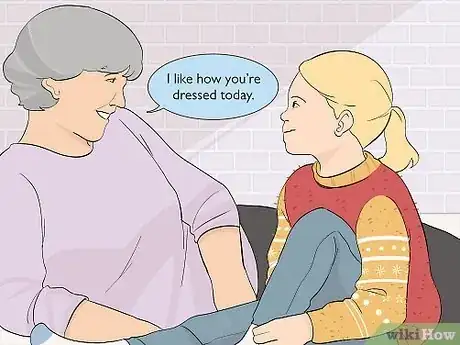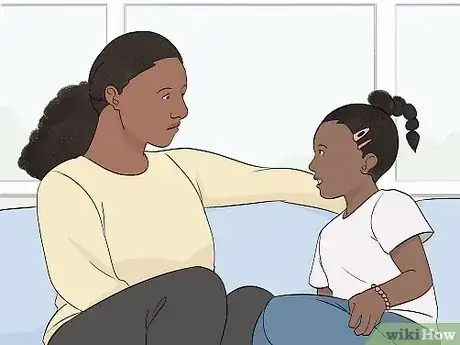This article was co-authored by Leslie Bosch, PhD. Dr. Leslie Bosch is a Developmental Psychologist, National Board Certified Health and Wellness Coach, and Owner of Bosch Integrative Wellness. With over 15 years of experience, she specializes in providing stress relief coaching services to individuals and groups using a variety of scientifically proven methods for change including motivational interviewing, positive psychology, self-compassion, non-violent communication, social learning theory, and self-determination theory. Dr. Bosch received training from the Andrew Weil Center for Integrative Medicine at the University of Arizona and earned a PhD in Human Development and Family Studies from The University of Arizona. She is also a member of the National Board of Health and Wellness Coaching Association. Dr. Bosch has published many papers and been featured in the media numerous times.
There are 23 references cited in this article, which can be found at the bottom of the page.
This article has been viewed 38,801 times.
Being a role model is difficult work. Being an acceptable one requires avoiding many pitfalls that can lead children down paths of harmful feelings and behaviors, the same displayed by many public figures such as movie stars, athletes, and politicians. Being a great role model requires mastering communication and behavior that at once resonates with children and provides them an example to follow throughout life. With greater awareness of your own habits, as well as knowledge of how children think, you can serve as an inspiration that changes lives.
Steps
Communicating Properly
-
1Speak to kids as individuals. Once you grow up, you lose touch with your childhood. As a result, you will find yourself thinking of children all in the same way. Many adults adopt a broad approach made to fit the concept of “kid” and, as such, forget how they wanted to be treated when they were young. Adults don’t want to be talked down to, and neither do kids.[1]
- Don’t lump them all together. Whether your reasoning is age or expectation-related, doing so prevents you from appreciating individuality.
- It’s easy for adults such as parents to get absorbed in the responsibilities that come with authority, but they’ll remember someone who is personal and friendly rather than someone who dictates.
- Try doing things like shaking their hand and asking non-patronizing questions. Ask about their viewpoints, like “What do you think about the news yesterday?” in order to get to know them and further customize your speech to them.
- When speaking to them, don’t jump to conclusions about how they think and feel. Instead of saying, “You must have felt angry,” let them express that in their own words.
-
2Don’t try hard to impress kids. A common mistake adults make is to overcompensate for their discomfort around children. They’ll raise their voice in a childish way and make awkward praises in order to get on the child’s good side. Many fall into this extreme in order to assuage the burden of having to pose as a confident, authoritative adult.
- Avoid sounding insincere. Instead of saying, “Good job!” in a drawn out, lilting tone, say, “I like the way you took the initiative to take out the trash.” Be specific, personal, and convicted.
- Don’t feel the need to point out every action the kid does, exaggerate it, or compare it what others are doing. These mistakes make your praise sound inauthentic and kids will begin to lose confidence in their own abilities.[2]
Advertisement -
3Adopt an appropriate tone. This is situational, but knowing when to make your words sound the way you intend is critical and requires practice. Children infer a lot from tone, so sounding dismissive when they tell you about themselves, whether that be getting a hit in a baseball game or a serious problem, for instance, distances yourself from them. Your tone should be appropriate and non-threatening.[3]
- Yelling and screaming is reactionary when something bad happens, but you’ll have more of an effect as a role model by handling problems the cool and collected way. Rather than get mad about that broken vase, say, “It’ll be okay. Accidents happen.”
- It is useful to vary your tone to match their feelings. For instance, you’d want to express pride and enthusiasm during an accomplishment or seriousness after a bad experience.[4]
- Public figures such as teachers should remain professional without sacrificing warmth. Rather than say, “This is the greatest writing ever!” or “This writing is terrible,” say “I like the way you’ve started. Do you want me to help you?”
-
4Speak simply and directly. While in many ways children feel and learn the same way adults do, they communicate very differently. The younger the child, the less capabilities they have in abstract thinking and the less attention they have for your spiel. When trying to get a child to get somewhere on time, rambling on about why they won’t make it doesn’t show them the consequences but does cause them to tune out.[5]
- Address the child by name, then put the point you’re trying to make up front. Avoid rambling and displaying uncertainty in your message.
- Pay attention to how kids speak and mimic that. You’ll see them use short words and sentences.
- Monitor your own speaking patterns with children. If you go on too long or in a way they can’t comprehend, they’ll appear disinterested. Use this to make adjustments.
-
5Be encouraging rather than critical. Kids make mistakes. They struggle at school. They don’t listen to your directions. Consider how much you like being berated and having your mistakes put on display. The way you relate to a child is a key factor between you being a role model or them spiraling down into resentment.
- Instead of yelling at a child for struggling in school, for instance, make a point of acknowledging their efforts to improve. Show your support. Cheer them on.[6]
- Use words of encouragement rather than negative corrections. Demanding they out the trash later provokes a negative feeling compared to saying, “You’ve been doing a good job remembering to take out the trash.”[7]
- Displaying belief in them is a sure way to indicate to them that they deserve self-worth and can improve in whatever area is difficult for them.
-
6Express positivity. Children unconsciously pick up cues for their parents. A gloomy, anxious parent, for instance, spreads a mood that the child adopts, which can lead to depression and anxiety.[8]
- Read any book on inspirational sports athletes. You’ll see that the best role models encouraged them by instilling the self-confidence needed to deal with life’s obstacles.
- Instilling a positive attitude doesn’t mean you need to be unrealistic. Handle situations with healthy optimism because delusional thinking can lead to later problems if the child doesn’t understand consequences and how to deal with them.
-
7Invite them to speak. The last person a child respects is someone who they feel refuses to listen to them or value their thoughts and feelings. The dynamic between you and a child should feel relaxed and more equal than authoritative.
- A possible way to do this is to meet children at their level. Instead of lording over a young kid, for instance, try squatting or kneeling.
- Conversation comes from open-ended questions. Many adults use this trick to converse with other adults. Instead of asking for their dog’s name, invite the child to tell you about the dog.[9]
- It is tempting to simplify questions into those that provoke closed, one-word answers. If the child is unresponsive, change your approach in a way such as offering an entertaining narrative or try again later.
-
8Show affection. Naturally, a display of coldness such as crossing your arms, turning away, and not smiling will suggest to anyone, including a child, that you’re not interested in them. If you’re a potential role model such as a parent, this has devastating consequences, including showing kids that you don’t care to reason with them or offer respect. Your body language should be in sync with your words.
- Offer smiles with your praise. Smiles that are sincere feel open, familiar, and comfortable while making you appear genuine.[10]
- Proper eye contact is a must. Offer just enough to connect with kids personally. A lack of it displays disinterest or a lack of confidence. Too much feels invasive or even authoritarian.
- Even your presence can lend strength. For instance, sitting close to a child when discussing a serious issue suggests you support them.
-
9Learn to be an active listener. It’s easy to hear what someone’s saying; it’s hard to hear what someone means. Most people in daily life don’t put in the time and effort to truly get to the heart of what someone else is trying to tell them. For children, this is important because they may be unable to tell you outright and instead express this through actions that can be cemented by an inappropriate response from you.[11]
- Mirror the child’s apparent feelings to try to get to the bottom of the issue. Instead of saying, “You must be sad,” say, “You might be sad” to avoid making an assumption.
- The wrong way to actively listen is to add epithets in an attempt to teach a lesson. Saying something like, “Big girls don’t cry” is demeaning and devalues the child’s emotions.
Modeling Through Behavior
-
1Set good habits for yourself. Psychological studies show that children learn through imitation. While issues such as domestic violence and alcohol abuse are considered cyclical, behavioral imitation extends to habits far less obvious.
- For instance, it isn’t enough to talk about eating healthy or saving money. If a child sees you being irresponsible by ignoring finances or eating lots of fast food, chances are that will become a habit of theirs too.[12]
- The more routine you make the behavior and the more positive examples of the behavior the environment holds, the more the behavior becomes normal for the child.[13]
-
2Take responsibility for your actions. You’re human. You make mistakes and swear on occasion. To be a role model, you don’t have to be perfect; rather, it is important for you to own these mistakes and use them as a learning opportunity. Remember that excuses make your own behavior appear acceptable.
- First, accept personal responsibility. Apologize sincerely if necessary. Owning up to your mistakes is difficult but honest and therefore impressive.
- Second, seek to remedy whatever problem arises from your actions. This can be anything from having an honest discussion with a child after missing an event to helping a stranger in the street. Once the strength of your character is apparent, it’ll inspire those around you, including kids.
-
3Stick to your rules. It’s easy for an adult to change their mind. If you’re a parent, you may feel tempted to undo a punishment once a child flashes a cute, innocent smile or offers an insincere apology. This causes the child to find ways to avoid punishment not because they’ve learned better, but because they’ve learned that the repercussions of their behavior are inconsistent.[14]
- Consistent rules invoke transparency and expected consequences which reinforce that the action that merited punishment was wrong.
- An unrelated adult such as a teacher still needs to keep their words and decisions consistent. This may mean making a tough judgment call to do what you consider right despite the scrutiny of parents, but the goal is to be consistent without being harsh.
-
4Open yourself to others. Often, the people who have the biggest impact on others are the ones who are able to effortlessly display compassion. You don’t have to fund charities or serve terms in volunteer organizations (though those can help), but you do need to display positive emotions to anyone you meet in life.
- For instance, someone who presents a positive, happy face in a school cafeteria and takes the time to get to know the children is more likely to have a personal impact in a child’s life than someone who gives millions to charity while showing no compassion in daily life.[15]
- Be loyal to those around you. Whether that is with a difficult friend, a local business, or your own values, kids will notice your consistency. It's a unique trait in an era where friends can be removed from social media by the click of a button.
- Subdue your negative feelings. Instead, show commitment to values such as positive social change or causes such as charity work. Civic engagement and acceptance of others make for great role model displays.[16]
-
5Show your ability to overcome adversity. Think of why athletes are such popular role models. Other than media availability, many of them have fascinating stories of triumphing in the face of bad life circumstances such as loss and poverty. They had to work hard to get where they are, proving the worth of persistence.
- For example, black male students suffer a disproportionate rate of failure in school, but a school that brought in role models who had overcome adversity and had the students imitate them caused student achievement to improve.[17]
- You don’t need to have survived a genocide to have a moving story. Search your childhood and work history for issues that challenged you and share these with children when they face similar struggles.
-
6Manage negative emotions. Feelings allowed to fester are ones that have severe consequences on relationships. You can tell kids to be patient on the road all you want, but if they hear you swearing up a storm at other drivers, they’ll adopt that attitude for themselves. Find more positive outlets for expression.[18]
- Instead of burying your feelings in chips and ice cream, exercise, for example. Teach self-control by example.
- Be careful with the relationships you keep. Many kids come from broken home lives and you don’t want to be a contributor. Forgive gracefully and avoid talking negatively about someone behind their back, especially where a child can hear.
-
7Display dependability. Humans can seem like different people depending upon how their moods go, but good role models are known by the positive qualities they display regularly. Expressions such as “like father, like son” hold true because kids see and mimic behaviors. That means they also see when adults aren’t following up their words with behaviors.[19]
- ”Walk the talk,” so to speak. If you promise you’re going to spend time with a child, for instance, follow through on that promise or your word is meaningless. “Do as I say, not as I do” never works.
- Your body language and actions should always indicate that you’re there for support. This applies to whatever lesson you teach, such as self-respect and generosity. Choose the legacy you offer.
- Step back and examine your actions for consistency. When you tell kids to be self-respecting and compassionate, do you end up in destructive relationships? Hypocrisy will cause kids to find alternative role models.
Avoiding Negative Role Models
-
1Limit the influence of celebrities. Everyone who thinks of a bad role model first goes to celebrities. Unfortunately, they get a lot of media attention for their worst behavior. This attention has the effect of normalizing the behavior for kids. They see someone they admire doing it, so the behavior becomes learned through admiring success.[20]
- Avoiding these role models requires forming a strong relationship with the child. If the child respects you and values your presence, they will be more likely to hear what you say.
- Ensure that they realize there is a difference between public performance and private life. For instance, children are often wowed by athletes who command a lot of intention, but society often conflates winning a championship with being a good, responsible individual.
- Find out what the child thinks of the behavior. Ask, “What do you think of that football player shoplifting?” Help them to understand, if necessary, then help them find ways the celebrity could have done better.
- Ensure the child knows they don’t have to emulate all qualities of a bad role model.
-
2Manage peer groups. The other common example of a role model is a peer. Peers for kids are important, because they allow kids to grow and gain experiences that help them to navigate the world, but still, bad friends can impart many bad lessons. Limit their influence by setting a better example.
- For children who struggle socially, find ways to teach proper interactions. Display these interactions in your own life, but also consider using the services of a therapist or teaching them such skills as conversing and problem-management.[21]
- Give kids opportunities to interact. For younger kids, you can have them together in a safe environment where they can play. Older kids still have to be allowed to make their mistakes and solve their problems.
- The earlier you stop bad behaviors such as a bad attitude or drug abuse, the better. During calm periods have discussions with the child, but focus on the behaviors rather than attacking the bad peer.[22]
- Instead of forbidding the relationship and driving the child further towards the peer, institute rules such as having the peer over when you’re around.
-
3Find out what qualities the child identifies in a bad role model. When it comes to an athlete who happens to be involved in lascivious and violent behavior off the field, the child will see things such as wealth, fame, personal success, attention, and freedom. While these may seem nice to have, the negative lessons also come with them. Once you find these qualities, you can try to switch their attention to a role model who embodies similar traits in a positive way.
- Be sure to teach them that every person has good and bad qualities. It can be helpful to not portray yourself as an infallible parent or public official. Own your own mistakes and adversities.
-
4Steer kids towards better role models. If you don’t, you can leave a blank in the child’s life where they aren’t sure who to look up to and can therefore end up going back to the bad role model.[23]
- It can take some compromising to find a substitute. You may find another athlete, for instance, who embodies positivity, or you may have to look to someone who never made the professional levels and had to go into a different field.
- Talk about the people you look up to for inspiration. If you can explain your own feelings, hopes, and weaknesses, you can share these with kids to reach them in a personal and relatable way while providing them a better role model.
References
- ↑ https://www.theguardian.com/lifeandstyle/2016/jan/30/how-to-talk-to-children-even-if-you-dont-have-any
- ↑ http://www.parentingscience.com/effects-of-praise.html
- ↑ http://www.quickanddirtytips.com/parenting/behavior/5-ways-to-speak-positively-to-children
- ↑ http://www.thekidcounselor.com/2007/03/healthy-interactions-with-children-tone-of-voice/
- ↑ http://www.askdrsears.com/topics/parenting/discipline-behavior/25-ways-talk-so-children-will-listen
- ↑ https://www.scholastic.com/teachers/articles/teaching-content/how-you-can-help-children-solve-problems/
- ↑ https://www.responsiveclassroom.org/want-positive-behavior-use-positive-language/
- ↑ https://www.psychologytoday.com/blog/high-octane-women/201210/emotions-are-contagious-choose-your-company-wisely
- ↑ http://io9.gizmodo.com/scientific-studies-explain-the-best-ways-to-talk-to-chi-582531307
- ↑ http://inspiyr.com/9-benefits-of-smiling/
- ↑ http://www.csuchico.edu/chld/lab/guiding-behavior.shtml
- ↑ https://www.washingtonpost.com/news/parenting/wp/2016/03/24/how-to-be-a-better-money-role-model-for-your-child/?utm_term=.62ab43fcba07
- ↑ http://www.raiselearning.com.au/blogs/news/5863603-learning-through-routines
- ↑ http://www.parents.com/kids/responsibility/values/its-not-my-fault/
- ↑ http://time.com/4397086/minnesota-shooting-philando-castile-role-model-school/
- ↑ http://www.rootsofaction.com/what-is-a-role-model-five-qualities-that-matter-for-role-models/
- ↑ https://www.good.is/articles/how-one-principal-recruited-role-models-to-motivate-his-black-male-students
- ↑ http://www.allprodad.com/10-ways-to-be-a-role-model-to-your-children/
- ↑ http://www.easternflorida.edu/community-resources/child-development-centers/parent-resource-library/documents/parents-powerful-role-models.pdf
- ↑ https://centerforparentingeducation.org/library-of-articles/focus-parents/role-model-promise-peril/
- ↑ https://childmind.org/article/kids-who-need-a-little-help-to-make-friends/
- ↑ https://www.empoweringparents.com/article/the-cool-kids-how-to-help-your-child-or-teen-deal-with-peer-pressure-exclusion-and-cliques/#
- ↑ http://www.aacap.org/aacap/families_and_youth/facts_for_families/fff-guide/Children-and-Role-Models-099.aspx















































































